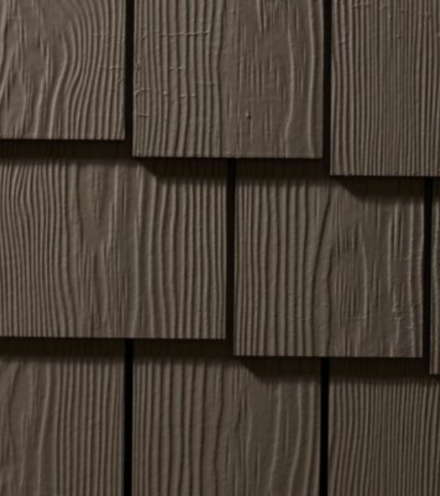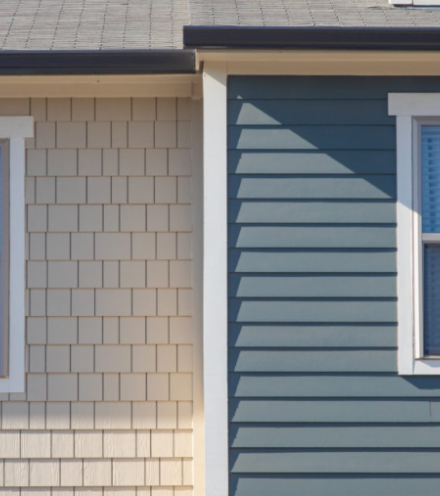
Ask any home designer, and they’ll all agree: the details can often make or break the entire visual impact of a home’s ambiance. On the interior, these details may refer to lighting fixtures and paint colors, but on the exterior, it often refers to decorative fascia and finished trim that can complete the look of the home and boost its curb appeal.
Not only does exterior fascia bring visual value to a home, but it also adds a layer of protection in a very vulnerable area of the structure. That is why choosing the right fascia is essential for both form and function.

What is Exterior Fascia?
Exterior fascia is a specific type of trim featured on some regions of the home’s exterior. Fascia is typically a single board or band that fits just below the roof’s edge, covering the vertical surface between the roof and the soffit. Depending on the home’s unique architecture, you can also apply fascia just below the rain gutters.

Decorative Fascia Styles
One of the most critical roles of fascia is providing a seamless, finished look for the crevice that it covers. Without fascia, the underside of the roof can look crude, drab, and incomplete. Decorative fascia provides a visual outline that emphasizes the more integral parts of the home’s architecture and design.
Smooth, solid-color panels are common, but decorative fascia is also available in various textures, including natural wood grain and ribbed cuts. Some choose to cut fascia into intricate gothic and fluted patterns, a decorative style symbolic of Victorian architecture.
Many homeowners opt for white fascia to create strong visual definition and match gutters and window panes. However, other neutral colors, like black and brown, are gaining in popularity, too. The most important thing is to select a color that is featured in other areas of the exterior so that it appears intentional and coordinated.

The Protective Purpose of Fascia
More than just a pretty face, exterior fascia also serves an important purpose. Without fascia, the rafters would be left exposed and open to more direct damage from the weather. Fascia covers the seam between the roof and the soffit, providing an extra layer of protection from rain, snow, and wind, which can all do significant structural damage to an unprotected home.
Besides serving as the first line of defense against weather, exterior fascia also protects against another common threat: pesky critters, like squirrels, birds, and raccoons, looking to nest someplace warm. Burrowing into the rafters can be incredibly attractive to rodents, so exterior fascia performs a vital role by blocking off access to crawl spaces and attics.

Traditional Fascia Materials
Wood is one of the most common materials used for traditional fascia. Wood offers some advantages, like being affordable and easy to work with, but it will certainly degrade over time.
Insect damage, rotting, and warping are some of the most common problems faced by homes with wood fascia. Wood also requires significant upkeep, such as regular repainting. Aluminum and vinyl are two other traditional fascia materials that require routine maintenance due to denting, scratching, and color fading. Vinyl fascia is particularly susceptible to wind damage, and it can be torn right off the home in severe weather, leaving the rafters and eaves exposed.
Traditional fascia materials are often used just out of familiarity because they have been used for decades, rather than a thoughtful approach to providing reliable protection that doesn’t compromise style. They offer a certain level of protection against the elements, but they are by no means failproof.

Fiber Cement Fascia: The Best of Both Worlds
Homeowners who value low maintenance, increased durability, and long-lasting performance tend to select fiber cement fascia. An innovative building material that proves itself much more durable than traditional fascia materials, fiber cement is a worthy defense against outdoor elements and invasive critters. Improved durability translates to fewer chores and routine expenses for homeowners since minimal maintenance is required to keep fiber cement fascia looking its best. Warping, rotting, color fading, and insect damage are the issues that homeowners can forget about when choosing to install fiber cement fascia.
Fiber cement fascia is available in an attractive array of colors, textures, and styles, meaning that it’s easy to select a decorative fascia option for any home. If you are looking for a smooth and seamless surface or a decorative fascia style that shows off a charming wood grain pattern, fiber cement fascia offers it all.
Before settling for the same old fascia materials, consider exploring all the available options with fiber cement fascia. It’s an exterior building choice that delivers superior performance in both form and function.
Reach out to a fiber cement specialist at Allura today for more information on fiber cement fascia and decorative trim.




